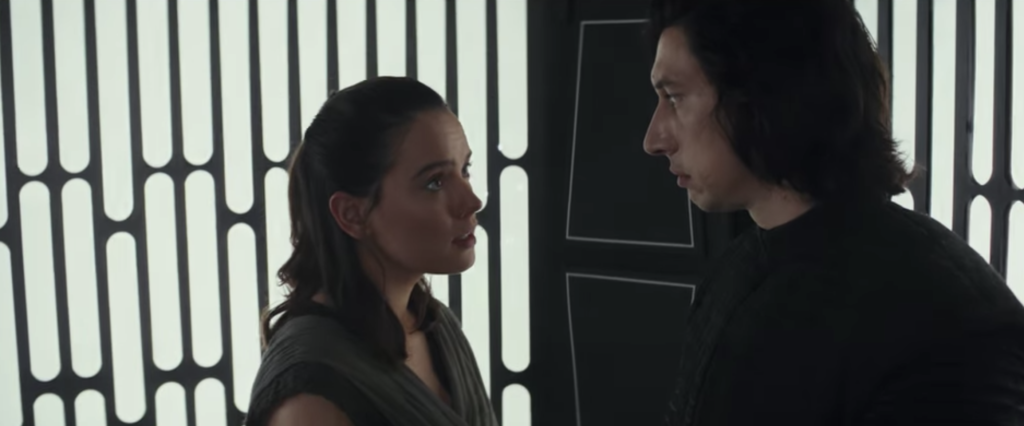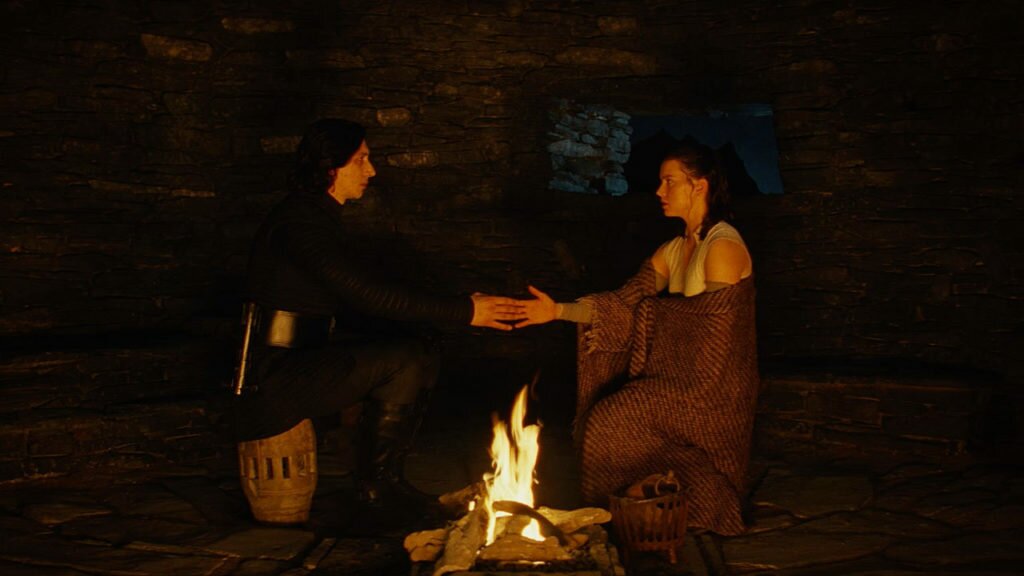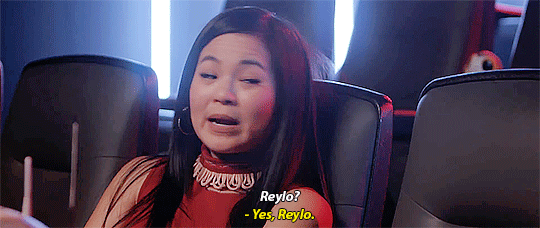Authors note: Firstly I just want to give a huge shoutout to the incredible work being done by the hosts of , Charlotte and Caitlin. They were generous enough to share with me their thoughts on Reylo for this piece and are perhaps the brightest light in Star Wars fandom right now. I’d also like to acknowledge that this is a contentious topic for some and that what I’ve written below was done so with respect and genuine love for the franchise and from the perspective of a fan. One day I’d like to do something more critical and in-depth but to celebrate the anniversary of The Last Jedi, I just felt like sharing some thoughts – if you disagree, agree or land somewhere in between, I’m always open to conversation on Twitter.
Also, and this part matters to me a fair bit, I’m just one guy with an opinion. Seek out other voices, there are women and POC doing incredible work in fandom right now and they deserve your attention.
(Literally) Across the Stars
Depending on your certain point of view, ‘Reylo’ is going to be very easy to understand or very confusing.
But first, a quick history lesson. When Disney purchased Lucsasfilm way back in 2012 two questions, among dozens, rose to the forefront – are we finally getting episode sequels and if so, what in the name of Mustafar would they be about? While the first question was answered relatively quickly with an obvious and much welcomed yes, the latter would go on to prove a little more mystifying. Under the creative direction of industry veteran Kathleen Kennedy, Disney announced to mixed reactions that the new Star Wars films would be discarding all previously established canon and crafting an original story. The continued adventures of the original trilogy’s heroes were assured, but with these legacy characters relegated to supporting roles, who would be this generation’s Luke, Leia, and Han? And of course, who could possibly fill the shoes of one of cinema’s most iconic villains, Darth Vader?
Smash cut to 2018 and we are two-thirds of the way through the new sequel trilogy. We have a fantastic new group of heroes and a complex antagonist – but in answering those initial burning questions, something entirely new to Star Wars has awakened.
The latest films in the Skywalker saga, The Force Awakens and The Last Jedi, or the Sequel Trilogy (ST) films for shorthand, have undeniably pushed the narrative and meta-narrative boundaries of Star Wars. TFA was a loving homage to the original films, complete with practical effects and maybe a too close for comfort rehash of A New Hope‘s basic plot structure. While TLJ opted for the opposite approach – a critical reading of the Skywalker legacy, experimental filmmaking and an overt emphasis on complex character work. It’s important to note that neither film was objectively correct in its approach to Star Wars, a heated issue that has plagued fandom since the release of TLJ a year ago today.
While the differences between the films could be discussed at length, the similarities are where we find the heart of the ST – the increasingly complex relationship between the light and the dark. Star Wars, among other things, has always been about the struggle between two opposing philosophical/spiritual ideals, typically represented by ancient orders and political empires. The original films began with a mostly black and white approach to this conflict; the fascist Imperials are at war with the freedom-seeking Rebellion while the pristine hero battles and ultimately redeems the villain. The prequel trilogy did away with this simplified approach, instead telling a heavy tale of political manipulation, the hubris of religion and what could possibly drive a hero to become the villain. The ST, however, finds itself in uncharted waters, embracing the legacy of both trilogies before it while complicating the Star Wars narrative even further.
It does this in many ways that I could talk about until the twin suns come up but the core conflict of the ST rests entirely on the shoulders of two kids desperately trying to discover who they are. Our heroine, Rey, a hopeful scavenger from a desolate planet who is waiting for someone, or something, to show her her place in all of this *gestures to the overwhelming nature of the universe*. Our villain, Kylo Ren, the beloved son of Leia and Han, who was prayed upon by a great evil from birth and following a heartbreaking mistake feels trapped in a life of darkness.
Individually there are a plethora of conflicts the two characters endure but what makes the ST resonate so deeply with fans is its acknowledgement of the shared pain between them. Instead of positioning the two as opposing ideas or figureheads, Rey and Kylo’s similarities are the focal point, through which an intimate tale of empathy is being told. Rather than retreading the conflict of the previous films with these two characters, the ST asks something entirely new: what if the light and dark, the grand dueling natures of all things, connected.

This connection was first hinted at during J. J. Abrams’ TFA, which despite having a mostly traditional dynamic between Rey and Kylo, took time to carefully establish a bond between the two. The film is littered with hints that the two may not be as different as the traditional ‘good v bad’ dynamic would have you believe. One of their first scenes together sees Kylo attempting to extract information from Rey’s mind using the Force, only to discover her abilities are far beyond his expectations when she is able to use the link between them to see into his mind also. There are issues with interpreting this scene as something other than its surface value (which we will get into later) but for many fans, it was here that the balance between the two characters became clear and with that balance came agency for Rey and vulnerability for Kylo. Two characteristics that are crucially important in understanding what fans have lovingly dubbed ‘Reylo’ (Rey + Kylo = Reylo).
There are other glimpses of a Reylo connection in TFA (namely some very suggestive moments in a fairy tale like woods) but nothing could compare to what was to come in the second film, Rian Johnson’s TLJ. If Abrams planted the seeds for Reylo, Johnson affectionately tended to the garden and handed fans a beautiful rose (pun entirely intended). TLJ thoroughly subverted almost all expectations for the film but primarily garnered both high praise and low criticism for its handling of Kylo Ren. Johnson wrote Kylo as a sympathetic, Byronic hero of sorts and paired this shift with Rey’s growing uncertainty over her identity to further develop the link between the two of them.
Another critical piece of the foundation for understanding Reylo is appreciating the positions TLJ put the two characters in. In developing the idea of a Force bond, Johnson was able to connect Rey and Kylo to allow discussion and empathy to grow between them while removing the element of violence from their meetings. The ‘Force Skype’ scenes sidestep traditional hero/villain confrontation and instead forced the two into an open dialogue, culminating in one of the most moving scenes in Star Wars history. Once again, with Force flowing between them, Rey and Ben are able to feel each other from across the stars as they both gain even deeper insights into each other minds. For Rey, this means Ben is now completely aware of her longing to belong after her parents abandoned her. For Ben, Rey has now seen his conflicted soul laid bare, the potential for him to return to the light. For both of them, it means someone finally sees them, they have finally connected with someone. Time will tell if this connection manifests as platonic or romantic, or if at all in Episode 9, but from these scenes it’s not hard to imagine why some fans are in love with this connection.

What these films had done was kind of monumental; crafting a deep bond between Rey and Ben has shifted the narrative landscape of the ST far away from what has come before it. It was a turn, for both characters, you would think nobody could have seen coming…unless you were listening to certain voices in the fan community. The concept of a romantic (or platonic) connection between the two leads was predicted almost immediately after TFA by fans who recognised something special in their dynamic. The wait between films was, as it always is, painfully long and in the absence of continued canon, these intuitive fans began to craft an idea, something they wanted to see in SW, something that was exciting, new and just a little bit sexy – Reylo.
Many plot details and concepts were correctly theorised by the Reylo community in the lead up to TLJ, most predominantly the idea that the Force bond created in TFA would feature heavily between the two in subsequent films. Following the release of TLJ however, there are still large portions of the Star Wars fan community who seem unwilling to acknowledge these predictions and, at worst, are outright hostile to Reylo and its advocates. What causes this disrespect varies but since the release of TLJ especially, the fandom has been plagued by bad faith discourse and gatekeeping which is used to discredit the views of certain fans. This becomes all the more concerning, and unfortunately less surprising, when you take into account how the Reylo and other ST fan communities have been founded by and in support of women. These inclusive communities are an integral part of ST fandom, giving voices to those who may have felt isolated from previous Star Wars discourse, and a large part of this new expression is Reylo.
Which isn’t to say that Reylo is a wholly accepted lens through which to view the ST films – many fans have voiced criticisms of the idea due to the potentially problematic nature of Rey and Kylo’s dynamic. There are also concerns that the first female lead in Star Wars falling into a romantic relationship would be invoking a tired trope that many believe Rey to be beyond. Both concerns warrant exploration, especially when raised by informed voices whose primary goal is the betterment of representation, but for most questions raised about Reylo there are answers. For example, many have, rightfully so, pointed out the issues with Kylo’s dialogue to Rey in the TFA interrogation scene – the line “you know I can take whatever I want” is a troubling use of language that may have been addressed had these exchanges not been written exclusively by men. However, some poorly worded lines aside, this scene and many others like it in TLJ are geared toward exploring the equality between the two characters, the interplay between Rey’s growing power and Kylo’s diminished sense of self. Of course, there are no correct answers in this conversation and, much like the films which spurred it, Reylo continues to be largely about perceptions.

Few people understand this more than the hosts of Skytalkers Podcast, Charlotte and Caitlin. Their show, which has developed a dedicated and growing fanbase since its launch in 2017, has an emphasis on the nuance and artistic merits of the Star Wars films and surrounding culture. Skytalkers’ success is indicative of a larger trend in ST fandom – thoughtful and inclusive dialogues are rising to the top and are often from fresh perspectives. The majority of voices contributing to ST fan discourse, and Reylo specifically, are from millennials who are now at a perfect time in their lives to engage with the entertainment they love on multiple levels. When I asked the Skytalkers how they felt about Reylo being a millennial read on Star Wars they disagreed somewhat, “I wouldn’t say it’s necessarily a millennial take, but instead a modern understanding of the relationship with the Byronic hero. The sequel trilogy is a whole new take on what it means to be a hero, by exploring the heroine’s journey and really digging into what it means to have the Force be balanced”.
They touch on something about the ST, and indeed about Reylo, that I think truly represents where Star Wars and its fanbase is headed in the future. Millennial take or not, there is something inherently progressive about Reylo and the communities that have sprung up in the wake of the new films. These groups, largely organised through social media, are proving to be spaces in which women and LGBTQ fans are welcomed and have equal voices in the discourse – which as a long time Star Wars fan who has always wanted a space in which to talk about gay issues, I find particularly heartwarming. Beyond that, the vocal and huge financial support of Rey’s journey proves what those who were paying attention already knew about women in films. “The truth is the sequel trilogy is a tale for the modern audience” the Skytalkers tell me, “one who wants nuance to their villains, one who wants complexity in their heroes, and one who is familiar with the lore of Star Wars as a cultural phenomenon in our time as well as in-universe”.
So there you go, that’s Reylo (at least, from my limited viewing angle). The discourse is much bigger than this post so if anything in here has you interested I suggest seeking out other sources and expanding your knowledge even more. I’ll spare you the details of my personal feelings on the subject but I will say we are at a time in the Star Wars canon where balance feels especially important.
The saga films have always been about redemption and family – I’m hard-pressed to think of a more powerful conclusion to the Skywalker story than that of an intertwined pair who are destined to complete each other’s journey for both, one way or another.


Leave a Reply